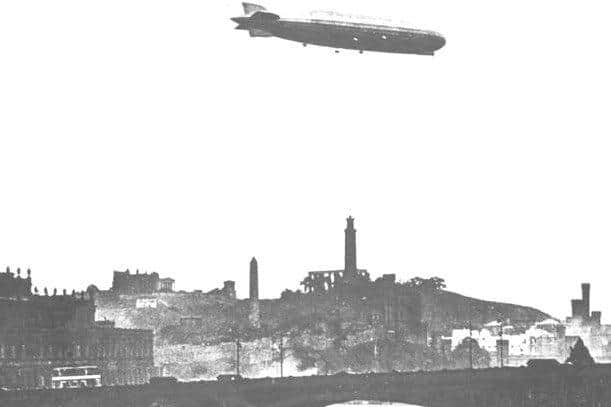On this day 1916: Zeppelin raid leaves 13 dead in Edinburgh and Leith
and live on Freeview channel 276
It was a night of terror and devastation the likes has never been witnessed in the Capital before or since.
On this day in 1916, dozens were killed or injured and a number of buildings destroyed during a zeppelin attack that marked Scotland’s first experience of a blitz-style air raid.
Advertisement
Hide AdAdvertisement
Hide AdFour German zeppelins set out from Nordholz airfield, with two of them managing to reach the east coast of Scotland.


Civilians were advised to take refuge at precisely 9.30pm when an order from the military was received to ‘Take Air Raid Action’. Road traffic ground to a halt and street lighting was lowered as the city responded.
The Germans’ mission was to obliterate the naval base at Rosyth in Fife and then destroy the famous and tactically crucial railway bridge over the Forth.
Fortunately for the numerous warships docked on the north shore of the Forth that night, the base escaped undetected.
Advertisement
Hide AdAdvertisement
Hide AdInstead, the Imperial German Navy Zeppelin L14 was attracted by faint lights emanating from the port of Leith.
Lasting approximately an hour, scores of bombs would be dropped across Leith and Edinburgh leaving thirteen dead and a further twenty-four wounded.
Following a successful raid on the docks at approximately 11:30pm, Zeppelin L14 managed to land a direct hit on the nearby whisky bond on Commercial Street. The stricken warehouse quickly lit up the surrounding area, creating a helpful beacon for the zeppelin to advance further inland.
One of the greatest tragedies that fateful evening occurred close to a railway sidings at Bonnington, where an explosion killed a baby boy who had been fast asleep in his cot.
Advertisement
Hide AdAdvertisement
Hide AdFollowing a winding streak of reflected moonlight, the Germans plotted a course along the Water of Leith towards Edinburgh where the zeppelin would continue to wreak havoc, dropping eighteen high-explosives and six incendiary bombs in less than forty minutes. Eleven people perished and a number of buildings, mostly tenements, were destroyed.
The bombs were dropped by hand and were roughly the size of a bag of flour.
Jonathan Ferguson, former assistant curator of military history at Edinburgh’s National War Museum, explained: “They were a very primitive method of ordinance. They were pretty subject to weather conditions, like wind and fog and they navigated using ground features.”
One bomb exploded outside the White Hart Hotel at the Grassmarket, killing one and injuring four. A flagstone located on this spot today marks the event.
Advertisement
Hide AdAdvertisement
Hide AdSix died at Marshall Street when a bomb landed on the pavement. While a young child aged just four was killed in a St Leonard’s tenement.
Edinburgh Castle was the subject of a narrow miss. Not long after one incendiary had smacked off the roadway of the Mound, a high-explosive hurtled into the west face of the Castle Rock, shattering a number of windows on Castle Terrace in the process.
The Capital’s legendary One O’Clock Gun was reportedly brought into action for the first and only time in its history to defend against the onslaught.
Several bombs were later found to have been dropped in empty patches of land including three in the valley of the Water of Leith, one in the Meadows near Jawbone Walk, and four in King’s Park. An incendiary was also discovered in the grounds of the Royal Infirmary.
Advertisement
Hide AdAdvertisement
Hide AdGunners positioned on the southern slopes of Arthur’s Seat saw off L14 for the final time around 12:30am. The second airship, L22, had ventured briefly into the city, able to cause only minor damage after jettisoning most of its bombs in fields near Berwick-upon-Tweed.
It was reported that Edinburgh and Leith citizens remained in a state of shock and stress for several months after the raid.
Despite the rudimentary bombardment methods deployed, the death and destruction witnessed on the night of 2 April 1916 would never be inflicted on Edinburgh on such a scale ever again - not even by the technologically-superior Heinkels and Junkers of World War Two.
Comment Guidelines
National World encourages reader discussion on our stories. User feedback, insights and back-and-forth exchanges add a rich layer of context to reporting. Please review our Community Guidelines before commenting.